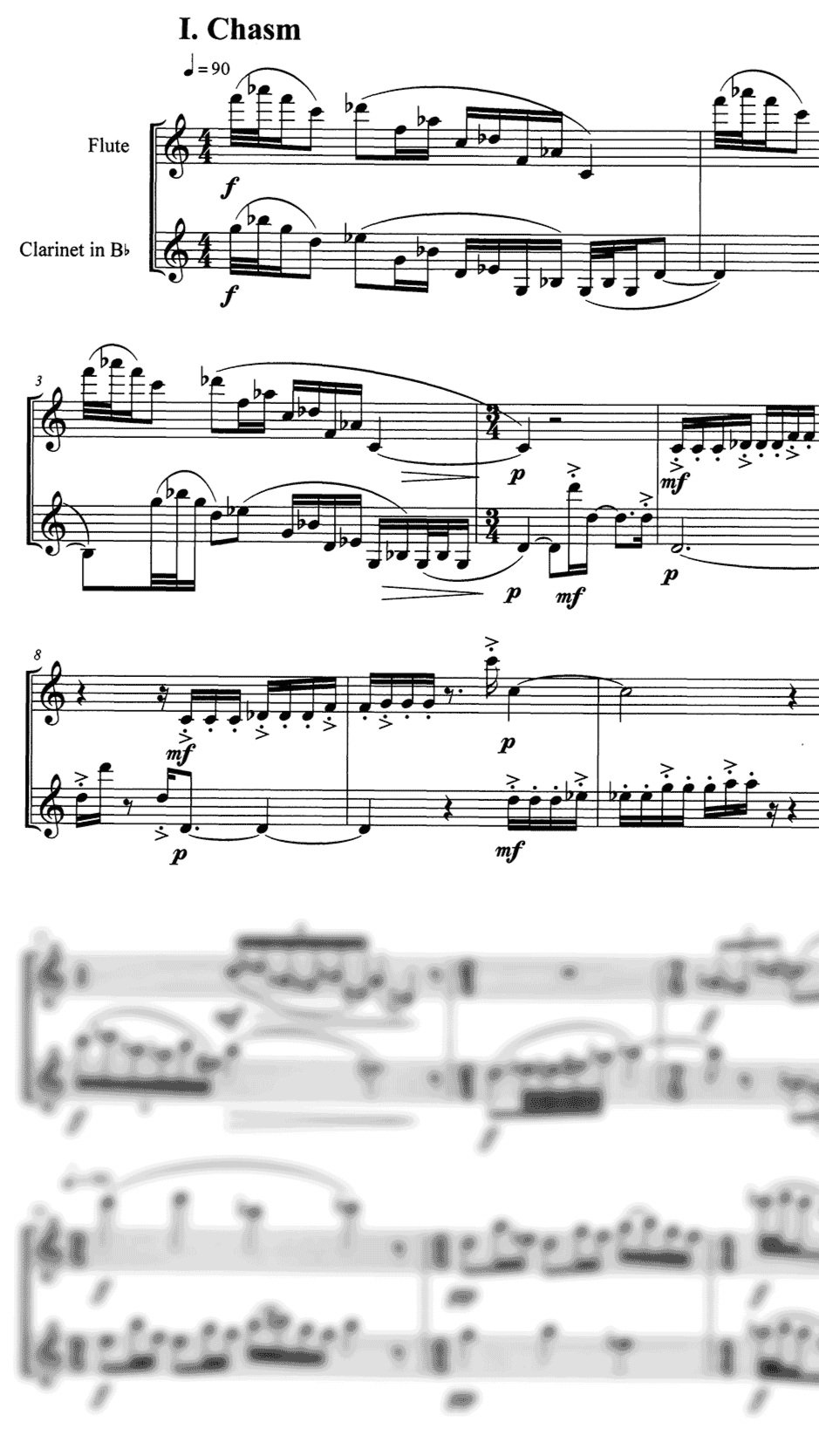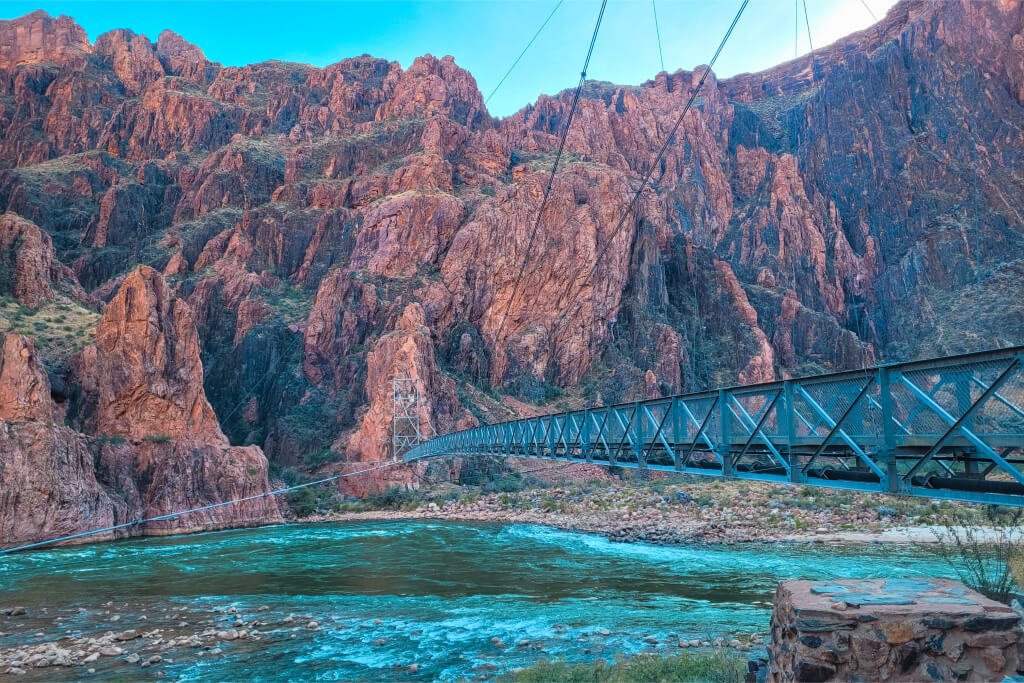Explorations
New Transcriptions for Flute and Bassoon
4:45pm, Clifford E White Theatre
IDRS 2024
Megan Lanz, DMA
Flute
Cayla Bellamy, DM
Bassoon
Dviraag is a fabricated word taken from the Sanskrit prefix "dvi" meaning "two" and the word "raag" loosely meaning "melodic mode." The pitch material for this piece is entirely based on a combination of two complementary pentatonic modes. The primary rhythmic material, introduced towards the beginning by the cello, was derived from a Carnatic vocal exercise I fondly remember learning as a child, in India. Of all the beginnerʼs exercises I learned, this one always stood out as being surprisingly challenging and unusual in its subdivisions. This exercise has become the basis for an exploration of intricate rhythmic subdivisions grouped into salient short phrases that recur throughout the piece in various contexts.
-notes from the composer
Originally for flute and cello
Commissioned by the Flute/Cello Commission Circle
I. Chasm
II. Uncharted Waters
III. The North Rim
IV. Phantom Ranch
V. Seeps and Springs
VI. Night Sky
VII. Carved
Originally for flute and clarinet
Commissioned by the Violetta Duo, Cayla Bellamy, and Megan Lanz
“You cannot see the Grand Canyon in one view, as if it were a changeless spectacle from which a curtain might be lifted, but to see it you have to toil from month to month through its labyrinths.”
-John Wesley Powell, The Exploration of the Colorado River and Its Canyons, 1874
The first European explorers to see the canyon in the 16th century were overwhelmed by the power of the intense Colorado River, so they gave up and left the area, which was left unexplored for over 200 years. The next explorer, Joseph C. Ives, after leading a survey expedition, infamously reported that the canyon was an impassable chasm and was valueless. History has proven him wrong. The first movement, titled, “Chasm,” depicts the initial hope of discovering the secrets of the canyon, with increasing dissonance depicting reality setting in that the canyon is an impassable wasteland. The parallel in life is that some things may, at first, appear attractive and desirable, but in the end they may become destructive or dangerous.
It wasn’t until artists and photographers accompanied geologist and ethnographer, John Wesley Powell on his expeditions down the Colorado River, that the canyon began to be known for its beauty and majesty. The second movement, titled, “Uncharted Waters,” depicts the danger of the turbulent waves, the power of the river, the fear of the unknown, and the spirit and perseverance of the explorers.
In the third movement, “The North Rim,” we finally see the big picture from one of the most impressive viewpoints of the canyon. The music invokes a sense of majesty, beauty, and scope, while also depicting a contrasting sense of serenity and solitude as you slow down and take it all in.
Nestled in the fourth middle movement, “Phantom Ranch,” is the “heart” of the Grand Canyon. Located at the bottom of the Grand Canyon along the Colorado River where the three main corridor trails converge, “Phantom Ranch” consists of log cabins designed by Mary Colter in 1922, at which one can only arrive by their own two feet, by mule, or by raft. The opening of the movement features a long descending line, depicting the journey down into the canyon. The arrival at the bottom is met with a sense of joy, exploration, and wonder.
The Fifth movement, “Seeps and Springs,” continues the exploration at the bottom of the canyon. With many hidden waterfalls and springs, the bottom of the Grand Canyon is a lush oasis, bringing your senses alive with the feel and smell of the cool water against the hot desert sun. Water can be found in many forms of motion, from dripping to cascading and roaring. Musically I tried to evoke these images of the life-giving waters of the Grand Canyon.
The sixth movement, “Night Sky” depicts the natural lightscape of the Grand Canyon. With no distortion or pollution, The Grand Canyon has one of the darkest skies in the country. The music depicts the emotions of peace and belonging one might feel gazing up at the myriad of twinkling stars in mystery and wonder.
The seventh and final movement, “Carved” depicts the creation of the Grand Canyon, which can be described with the acronym “DUDE.” The first letter stands for Deposition, which is a superposition of layer upon layer of rock. Second is Uplift, a release of pressure which causes the crust to be lifted high and flat. Third is Downcutting, which is when floods carry rocks down the canyon, acting as large chisels as they bounce along. Last is Erosion, which is when the earth breaks down from wind or water. My musical gestures, rhythms, and articulations try to capture the essence of both natural and Divine processes through which the Canyon was created.
In my lifetime I have been blessed with multiple opportunities to visit the Grand Canyon, from my childhood visits, to my three-year residency in Arizona. When the Violetta Duo approached me about writing a piece inspired by a National Park, my thoughts were immediately drawn to my memories of the Grand Canyon. “Labyrinth” was commissioned in 2022 by the Violetta Duo, Dorothy Maglione, flute and Madelyn Moore, clarinet.
-notes from the composer
-
This project is a commission consortium of three chamber music pieces every two years. For 2024, we are commissioning for flute and bassoon duo (one for alto flute and bassoon). Subsequent projects will include a multitude of other instruments.
Our Three-Part Mission:
Including New Voices
Making Finances Accessible
Exploring Contemporary Sounds
-
Click here to join.
Use code IDRS2024 for 50% off commissioning fees through Sunday. That's only $25 for students and $75 for professionals, including all three works! -
SoundCraftEd exists to fill a gap in student education by providing adaptable practice and problem-solving materials through consolidating resources we know work. We also wish to educate young musicians on the commissioning process and include them in an affordable way, helping to direct the future of our field. We feel it is important to model complex and multifaceted careers in music, to equitably pay composers for their work, and to continue conversations about pedagogy and compare notes as pedagogues. Our name encompasses exploring and advocating for new sounds, promoting high level craft, and educating performers, teachers, and audiences.












